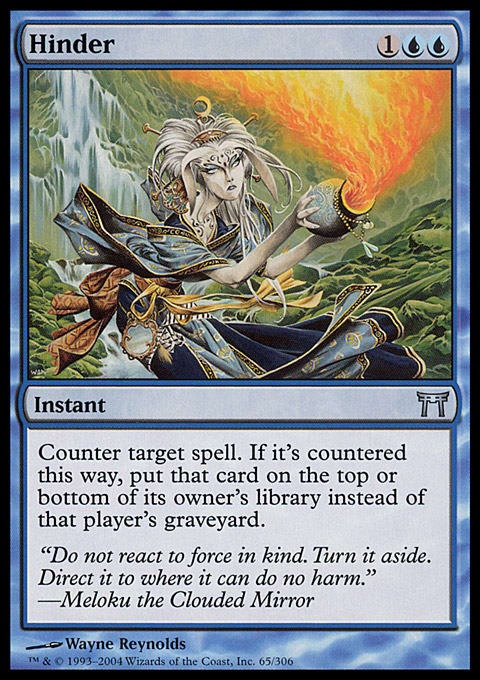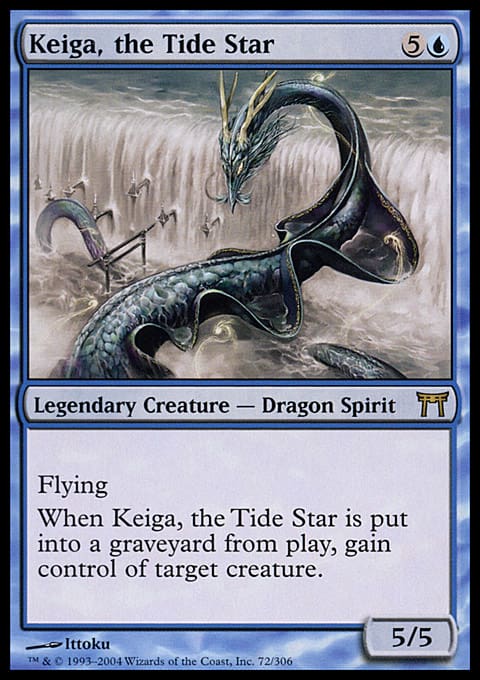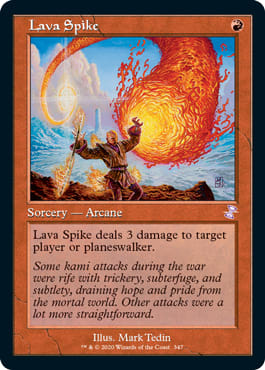Listen:
Or, Read:
According to multiple sources on the Internet, the original Kamigawa sold poorly.
Seeing as Wizards of the Coast is a business designed not only to "make money" but to generate a return for shareholders, it's nice - for us Kamigawa fans anyway - that they are giving it another go around. Even if, in hot pink. Especially with feedback like the following! I thought this old note from Mark Rosewater's blog particularly chuckle-inducing:
Me, personally... I loved Kamigawa on every level. Actually scratch that. Almost every level. I don't care about art or flavor historically, so the fact that the creative didn't hit doesn't bother me so much. Like, it is completely perpendicular to me that Sakura-Tribe Elder was a Snake (except maybe for some low Tier Snake-centered mechanics that I never had the time to explore personally, anyway). I cared that Sakura-Tribe Elder was a bonkers 2-drop that - entering Standard - could give Arcbound Ravager a hard time at the two. And not just "a" hard time! Over the years the little Snake Shaman has gathered up Islands for me, Mountains for Adrian Sullivan, and every kind of basic land (including more Forests) for both the boring-est sit-there decks AND the most explosive combo decks across several formats and metagames... All while absorbing the opponent's biggest attacker! Sit-there, combo, and everything in-between.
Kiki-Control | Standard | Adrian Sullivan, 2004 Champs - Wisconsin
- Creatures (28)
- 2 Duplicant
- 3 Hearth Kami
- 3 Rootrunner
- 4 Birds of Paradise
- 4 Eternal Witness
- 4 Kiki-Jiki, Mirror Breaker
- 4 Sakura-Tribe Elder
- 4 Viridian Shaman
- Instants (4)
- 4 Magma Jet
- Sorceries (4)
- 4 Commune with Nature
- Artifacts (2)
- 2 Sensei's Divining Top
- Lands (22)
- 11 Forest
- 7 Mountain
- 1 Okina, Temple to the Grandfathers
- 1 Pinecrest Ridge
- 2 City of Brass
- Sideboard (15)
- 3 Arc-Slogger
- 3 Cranial Extraction
- 1 Duplicant
- 3 Electrostatic Bolt
- 3 Plow Under
- 1 Rootrunner
- 1 Swamp
Adrian has always been a creative deck designer, but his Kooky Jooky from 2004 Champs was kind of a work of mastery, wasn't it? I think we can forgive his egregious number of Sensei's Divining Tops (it was the first weekend the card was legal, ever; and to be fair, drawing a second isn't intuitively busted). Nevertheless, look at how this Gruul deck simultaneously attacked the metagame while delivering against then-brand new incentives.
The top deck going into Champs that year was - no surprise - Ravager Affinity, since Mirrodin block was still legal in Standard. So, Kiki-Jiki, Mirror Breaker plus Viridian Shaman are kind of just a couple of fast friends who realize in the moment that they have something they could prove to the world, together. But then Hearth Kami comes along and is like "Hey guys, I'm new around here, but I can be the 5th-7th Viridian Shamans (especially against Seat of the Synod or whatever); but like even faster. They're like "Cool man, we have some slots for you... Some of which are in the graveyard."
The graveyard, you say?
Adrian was copying em effing Rootrunner with his Kiki-Jiki, Mirror Breaker! That card has a little-known ability called Soulshift 3. Don't know what a Soulshift is? It's this:
So, copy Rootrunner. Have two open? Sacrifice the fake Rootrunner to manascrew the opponent a little. Trigger Soulshift 3 on the FAKE em effing Rootrunner. Is that a Hearth Kami in your graveyard? Might as well re-buy that piece while you're at it, am I right? Wouldn't want to leave a part of the buffalo unused.
Here's the thing: It only seems ponderously slow. Ravager Affinity was one of the fastest offensive decks in the history of Standard, but Adrian's Gruul could get a quick jump, then strand the opponent in Spiritual mud. Not only could it block / chump / set up with a turn two Sakura-Tribe Elder; copying a Sakura-Tribe Elder later with Kiki-Jiki was like casting Fog and Rampant Growth every turn for zero mana. It was wild.
When was the last time you read a deck analysis like this?
This wasn't even one of the dominant decks of the era! While Adrian "merely" made Top 8 of Wisconsin Champs with it; one of his buddies took first, and overall the deck placed in a couple other States. But despite some obvious near-term efficacy against The Deck to Beat AND its own super coolness... Other decks and other ideas simply rose in prominence.
Which is great!
Kamigawa Block was an important catalyst for me as a deck designer as well. I never came up with anything as creative as Adrian's so successful States deck, but I ended up breaking a lot of new ground philosophically. It all started with this:
Yeah!
Hinder was a card that might not even see play if it were legal today. It's comparable to Cancel on power level, and arguably a bit worse than contemporary takes like Dissolve and Sinister Sabotage. Though the three all have one thing in common: I won PTQs in three different eras with these three different three-mana Counterspells in my deck.
In 2004, People with any good sense at all were opening up on Arcbound Ravager, but lunatics like YT were trying to figure out how to use permission to control time. We got some help from one of Kamigawa's top-end threats.
Keiga and I did good work for the next two years, producing countless Grand Prix and Pro Tour performing decks. But it wasn't even clear that Keiga was the best top end Blue threat! In my lists it shared a lot of space with Meloku the Clouded Mirror; and in later stages, it wasn't even clear Keiga was the best Dragon. Over time, our Keiga shells supported memorable deck lists guest starring Yosei, the Morning Star or Ryusei, the Falling Star. That's part of the reason I'm quietly hopeful about this guy:
Nobody thought Ryusei was much good initially, either; but it ended up leading the Swiss at Pro Tour Honolulu, in the hands of Osyp Lebedowicz.
Earlier I mentioned low Tier Snake decks. Kamigawa's breadth helped to create space for exploration outside only the top decks. Patrick Chapin's very first professional article was about a hybrid Snake deck. Looking back, it's amazing to see how he blossomed from in-joke fake tournament reports into maybe Magic's greatest ever strategy writer... But I'm confident that the seeds that would grow into The Innovator - Pro Tour Champion and Pro Tour Hall of Famer - could not have been so successfully planted into more restrictive soil.
Kamigawa version one was the tip of the spear for a design philosophy called Tier Two. In contrast to Mirrodin, which was heavily based on playing the very specific best cards, generally together (Arcbound Ravager, Disciple of the Vault, Aether Vial, and Skullclamp), Kamigawa opened the world up by creating a spread of cards that were kind of all good enough to play, but weren't necessarily played in a specific deck [together]. To be clear, Tier Two cards aren't necessarily "worse" than Tier One cards; they're just less concentrated in their popularity.
A card that debuted a year later, Lightning Helix, is the quintessential Tier Two card. It's great in beatdown. It's great in control. It's backbreaking against beatdown. Sometimes you don't play it at all, or you only play two because - as good as it is - Lightning Helix costs two but only does three. You could play a Tier Two card or not; play another or not; find synergies; mix; match.
People like to talk about Umezawa's Jitte as a paradigm breaker for Kamigawa Block, but it wasn't even played in either of the Top 2 decks at the Kamigawa Block Pro Tour! For his part, Adrian played Kiki-Jiki in a Green deck. Most of us know Kiki-Jiki to be either a more Izzet card today, or a pure combo piece. Isn't it cool that you used to be able to do more, weird, different things with yours?
A Standard defined by the Tier Two philosophy later grew to be more closely identified with Ravnica Block, which debuted the following year. But I'm not sure if that's simply because Ravnica didn't have to contend with Tier One Mirrodin head-to-head.
The metagame world was so much wider.
According to this column I penned in 2006, over fifty distinct archetypes and color combinations were represented in the elimination rounds of that year's State Championships. Fifty! That's a result of the Tier Two design philosophy. You'll just have to believe me that I didn't remember when initially doing the research for this article that I had won the Champs myself that year! The Brian Kowal-designed deck I played is actually one of the best possible examples of this more open philosophy. I didn't play Remand. Pierre Canali (who had won a Pro Tour the previous season) thought this was crazy. Remand was the best card in Standard! And in-colors! Yet it was feasible for the best deck not to play it, despite being both in-color and in-strategy. Remember the rapid fire bans on cards like Field of the Dead; Oko, Thief of Crowns; Fires of Invention; and Omnath, Locus of Creation (but somehow not Winota, Joiner of Forces)? These are all Tier One cards. So, a fifty-deck format is not really something we could have seen in 2020 or 2021.
Today, fewer than eight archetypes make up the top 80% of Standard tournaments; and the distinctions between even these are kind of hair-splitting. It's pretty difficult to differentiate Izzet Turns and Izzet Dragons sometimes; and Jund, Temur, and Gruul Chariot decks are kissing cousins if ever there were three. A wise man could argue there is more philosophical distinction between different speeds of Mono-White decks than Gruul Chariots going in either color direction. I kind of get Blue's "moist" trickiness with all the Treasures, but you're going to have a hard time convincing me to splash Infernal Grasp when you don't even have the full four trips to the Forgotten Realms in your 8-12 Dragons deck. I don't know if fifty is the most skill testing number; but we're a far cry from ten decks.
None of this really signals a return to Tier Two design and development for 2022; only that that's what we saw the last time we visited Kamigawa.
Per Rosewater's long-ago comment, Kamigawa Block was considered to be one of Magic's creative low points. To me, this is another opportunity. Like I said, I'm not historically a flavor guy. But I'm not a flavor guy like I was once not a Brussels sprouts guy. When I was growing up, "Brussels sprouts" in the US was code for nutritional punishment. Of all the veggies you could push around your plate and not eat, Brussels sprouts were the most noxious of any not bought at the Asian supermarket. Cruel, cruel mommies (not even grade school cafeteria ladies) would boil them. They were worse than cabbage. Mushy. Homogenous. Gray.
But at some point in the last ten or so years, some chef figured out how to cook Brussels sprouts. Then... Bang! Cat out of the bag, everyone who has either visited any restaurant or opened TikTok intuitively knows how to cook them. Now I love them. Now everybody loves them! They're like French fries, even when they're not fried. Crispy. Seared black on one side. Dribbling with sour reductions or garnished with lardons. I didn't know I was a Brussels sprouts guy until there was a reason to be a Brussels sprouts guy.
Incumbent Kamigawa was the Brussels sprouts 1.0 of creative. It's not just what Mark said, that people didn't like it; I think they didn't understand it. I didn't!
Back in 2003, I thought I was going to be a famous comic book illustrator. I placed third in an international art contest that produced one of the comics industry's most celebrated creators, but also multiple other professionals at Marvel, DC, and smaller publishers. Jonathan Hickman didn't win the contest, either. But he finished exactly one spot ahead of YT. Your old buddy MichaelJ got a movie contract and, at the ripe old age of 27, an honest-to-gosh mention in Variety magazine.
My old Ohio road trip friend and neighbor Matt Cavotta had the flattering idea to collaborate on a Magic illustration for Champions of Kamigawa. I'd do one of my comics-esque breakdowns and he'd finish it Magic-style like Questing Phelddagrif or Goblin Piledriver.
It wasn't Matt's fault, but I never really wrapped my head around the concept of drawing an "instant" instead of a "dude". Kamigawa's flavor was fuzzy to me. Spirits had lanterns why? There are Ninjas? Can I just draw a Ninja? What do you mean it's a Spirit? Can it be a Spirit if I just put a mask on a Ninja kind of like in Spirited Away? Okay not actually a Spirit and definitely not a Ninja (even though there are Ninjas)... Tell me about being an instant instead of some kind of a dude again? An Arcane instant is what?
My card - originally entitled Bladereach - didn't make it into Champions of Kamigawa. Matt's final Flores-free version made Betrayers of Kamigawa as Hundred-Talon Strike, in the next set.
The Cavotta final was way more of a "spell" than any of my Bladereach attempts. But still, when you think Kamigawa Spirits... Is the first thing that comes to mind the lanterns?
Opportunity, and from such a low base; you know what I mean?
Just last week I ordered 100 matching full-art basics from Innistrad: Midnight Hunt and Innistrad: Crimson Vow from here on CoolStuffInc. [PROMO CODE "flores" :)] But the nice people in Renton, WA have already outdone themselves.
I just wish I knew first time around how compelling to my life Arcane was going to be.
You know why I'm excited about Kamigawa: Neon Dynasty? After close to thirty years, I think I might be getting ready to be a Brussels sprouts guy.
LOVE
MIKE
































